(CNN) — A deadly cold snap that is gripping East Asia has killed at least four people in Japan after subzero temperatures and heavy snow brought travel chaos during the Lunar New Year holiday, with climate experts warning that such extreme weather events had become the "new norm."
Japanese officials said all four of those who died on Wednesday and Thursday had been working to clear snow amid what Chief Cabinet Secretary Hirokazu Matsuno has called a "once-in-a-decade cold snap."
Two of the deaths were reported in the western Niigata prefecture, with one in southwestern Oita prefecture and one in southern Okayama prefecture — where the victim had a heart attack.
In neighboring South Korea, heavy snow warnings were issued this week as temperatures in the capital Seoul fell as low as minus 15 degrees Celsius (5 degrees Fahrenheit) and plummeted to record lows in other cities, officials said. Residents said it began snowing heavily overnight late Wednesday into Thursday.
On the popular tourist island of Jeju, harsh weather this week led to the cancellation of hundreds of flights while passenger ships were forced to stay in port due to huge waves, according to the Central Disaster and Safety Countermeasure Headquarters.
"Cold air from the North Pole has reached South Korea directly," after traveling through Russia and China, Korea Meteorological Administration spokesperson Woo Jin-kyu told CNN.
Woo said that while scientists took a long-term view of climate change, "we can consider this extreme weather — extremely hot weather in summer and extremely cold weather in winter — as one of the signals of climate change."
Across the border in Pyongyang, North Korean authorities warned of extreme weather conditions as the cold wave swept through the Korean Peninsula. Temperatures in parts of North Korea were expected to dip below minus 30 degrees Celsius (minus 22 degrees Fahrenheit), state media reported.
In Japan, hundreds of domestic flights were canceled on Tuesday and Wednesday due to heavy snow and strong winds that hampered visibility. Major carriers Japan Airlines and All Nippon Airways canceled a combined total of 229 flights.
Meanwhile, high-speed trains were suspended between the northern Fukushima and Shinjo stations, Japan Railway Group said.
China's meteorological authority has also forecast big temperature drops in parts of the country and on Monday issued a blue alert for a cold wave — the lowest level in a four-tier warning system.
Mohe, China's northernmost city, on Sunday saw temperatures drop to minus 53 degrees Celsius (minus 63.4 degrees Fahrenheit) — its coldest ever recorded, meteorologists said. Ice fog — a weather phenomenon that occurs only in extreme cold when water droplets in air remain in liquid form -- is also expected in the city this week, local authorities said.
Other parts of Asia also felt the impacts of harsh cold weather.
Earlier this month in Russian Siberia, temperatures in the city of Yakutsk stood at minus 62.7 degrees Celsius (minus 80.9 degrees Fahrenheit) — a record for a place widely known as the world's coldest city.
The cold was also felt in Afghanistan, where Taliban officials reported the deaths of at least 157 people as the country experiences one of its coldest ever winters with minimal humanitarian aid. Officials said temperatures in early January had plummeted to as low as minus 28 degrees Celsius (minus 18 Fahrenheit).
'New norm'
Yeh Sang-wook, a climate professor at Hanyang University in Seoul, attributed the extreme cold wave on the Korean Peninsula to Arctic winds from Siberia, adding that the cold wave in South Korea this year was partly due to the melting of Arctic ice caps from a warming climate.
"There has been a record melting last year and this year," he said. "When sea ice is melted, the sea opens up, sending up more vapor into air, leading to more snow in the north."
As climate change worsens, the region would face more severe cold weather in the future, he said.
"There is no other [explanation]," he said. "Climate change is indeed deepening and there is a consensus among global scientists that this kind of cold phenomenon will worsen going forward."
Kevin Trenberth, from the US National Center for Atmospheric Research (NCAR), agreed that "extreme weather events are the new norm," adding, "we certainly can expect that weather extremes are going to be worse than they were before."
He also pointed to the El Niño and La Niña climate pattern cycles in the Pacific Ocean that affect weather worldwide.
La Niña, which typically has a cooling effect on global temperatures, is one of the reasons for the current cold snap, he said.
"There's certainly a large natural variability that occurs in the weather but ... we often hear about the El Nino phenomenon and at the moment we're in the La Niña phase. And that certainly influences the kinds of patterns that tend to occur. And so that's a player as well," he said.
The-CNN-Wire
™ & © 2023 Cable News Network, Inc., a Warner Bros. Discovery Company. All rights reserved.

















































